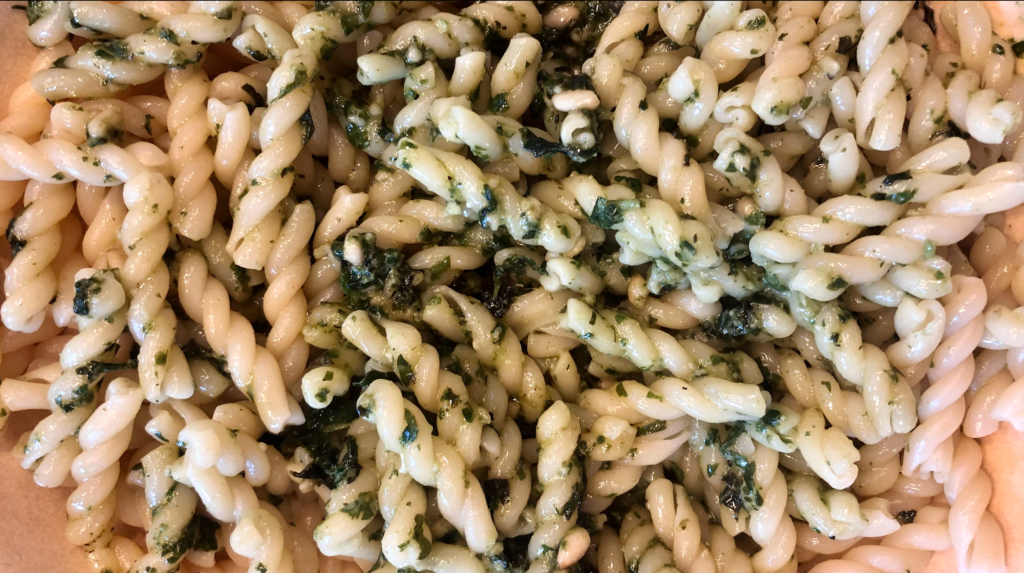I recently encountered an Italian who told me: “Kayla, pesto is my god.” This person was from Genoa, of course – the Italian city who birthed this very sauce.

Between this divine statement and basil season in full swing, I took this opportunity to make a batch of pesto.
Pesto comes from the word pestare, to pound. In the olden days, pesto was ground with a mortar and pestle. All you need is fresh basil, pine nuts, olive oil, salt, garlic, and pepper – really easy! The original ingredients, however included parmigiana or Asiago.
You don’t even need a recipe, as I do my pesto by eye. Whether you’re a little heavy on the garlic, pine nuts, olive oil, or basil, they’re such delicious ingredients it’s hard to go wrong! I recommend starting with this basic guideline in a blender:
- a generous handful pine nuts
- 2-3 cloves of garlic
- salt, to taste
- black pepper, to taste
- over 1/2 cup of extra virgin olive oil
- 3 handfuls of clean, dry, basil leaves. I always end up adding basil as I go.
Pesto comes down to few, simple ingredients.
- Gemelli. Trofie, spaghetti, and the flatter linguine and are all traditionally recommended for pesto. If you’re in Genoa, you’ll often find pesto enveloping pillows of gnocchi. In my opinion, the curves and grooves of gemelli, in particular, hold pesto well and allow for the herb-based oil to stick to the pasta.
- Basil. This herb works to fight inflammation, and is a good source of Vitamin A, a vitamin that supports bone growth and immune system. You may have seen variations of pesto with arugula, spinach, or even kale – but basil is the most delicate and traditional.
- Olive oil. This is KEY. You want a fruity, punchy olive oil, so make sure to pick out a trusted brand. It’s reliably reported that 80% of the Italian olive oil on the market is fraudulent, as many are mislabeled as virgin or extra virgin or mixed with other oils, like peanut oil. I recently discovered Illyrian Olive Oil. Otherwise, I trust California Olive Ranch or Tre Olive. On the nutrition front, olive oil is rich in healthy monounsaturated fats, has lots of antioxidants, and strong anti-inflammatory properties (such as having oleocanthal, which has been shown to work similarly to ibuprofen).
- Pine nuts. The book “Pesto Genovese: an Ageless Benchmark of Great Italian Cuisine,” writes that the ancient Romans ate a paste called moretum, prepared by crushing cheese, garlic, and herbs together – omitting pine nuts all together. Pine nuts are now a staple in a pesto recipe; if cost and rarity are concerns for you, some people blend roasted walnuts or cashews instead.
- Garlic. Garlic is rich in antioxidant compounds such as polyphenols and flavonoids, which support the body’s protective mechanisms against oxidative damage.

I suggest finishing off this meal with a sorbet, a pistachio cake, or biscotto and espresso, just like the Italians.
Looking for more pasta recipes? Check out these.
- Shallot Pasta (DF, but can be made GF + V)
- Gourmet Alfredo Macaroni and Cheese (GF + V)
- Pesto pizza (GF + V)
- Gnocchi alle spinaci con piselli e cipolla (GF + V)
- Spaghetti aglio e olio (GF + V)
- Spaghetti alla Nerano (GF + V)